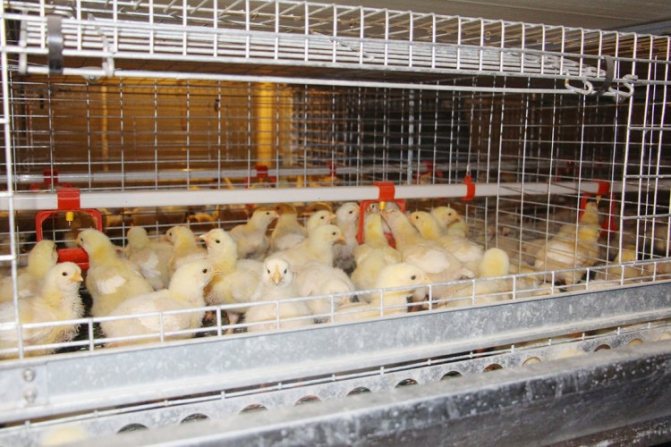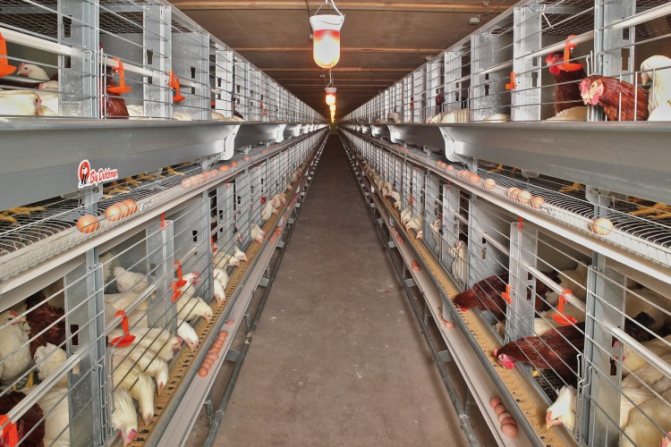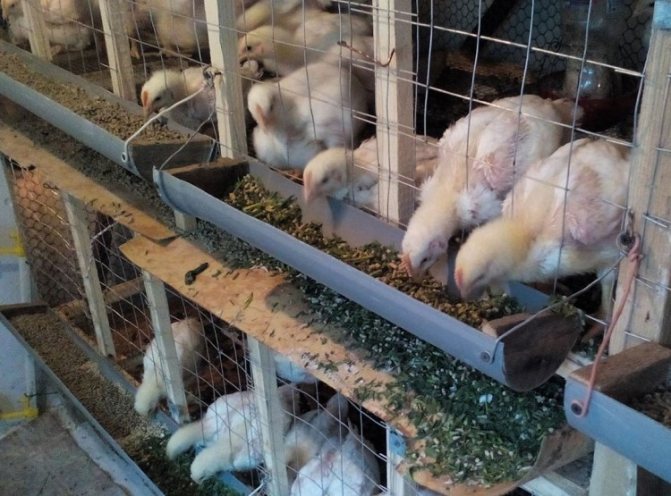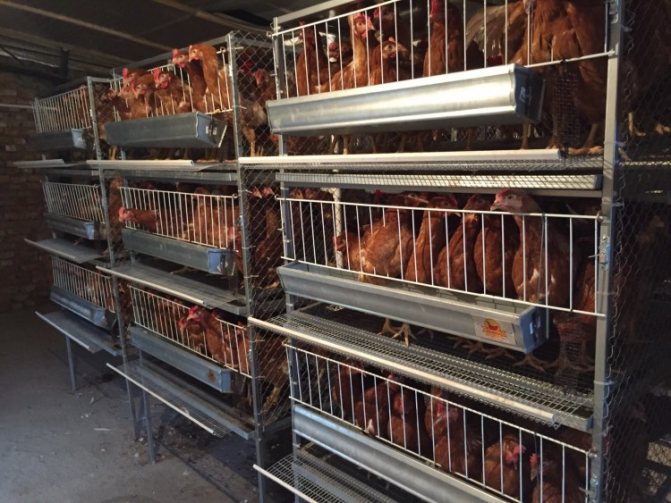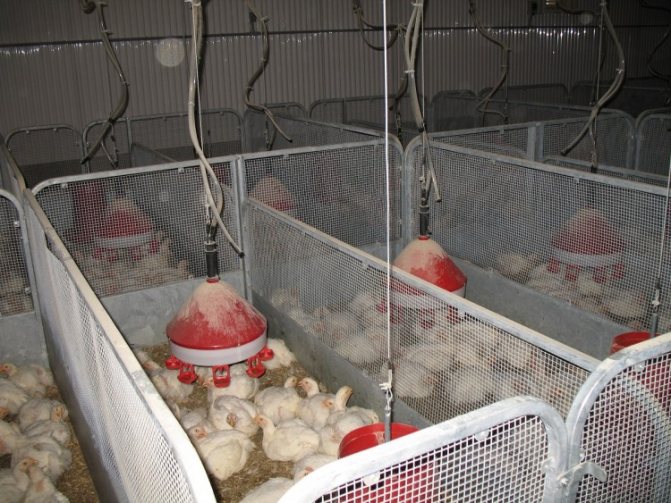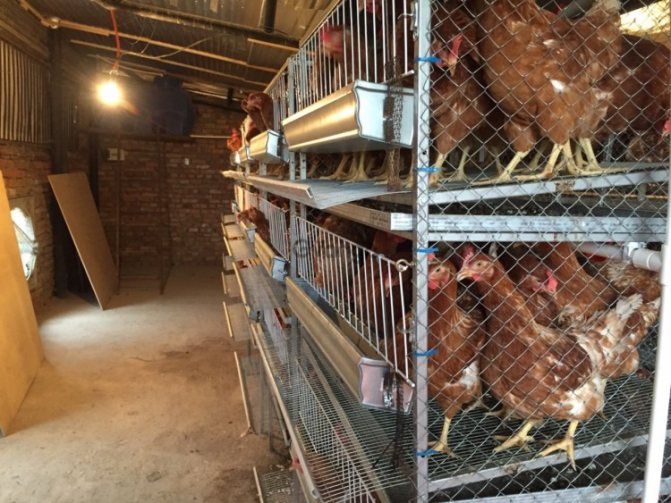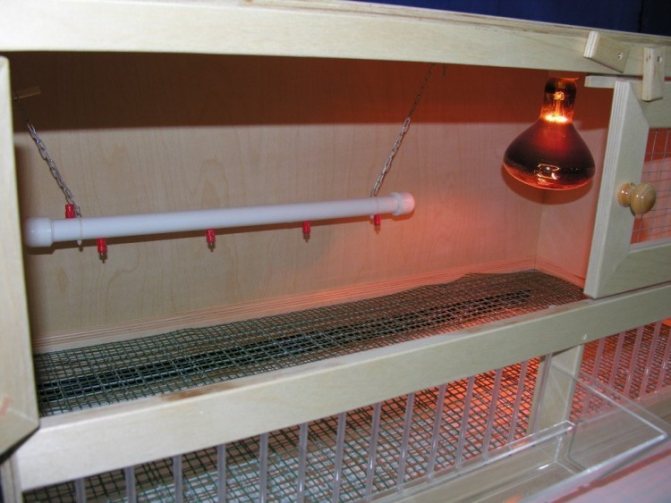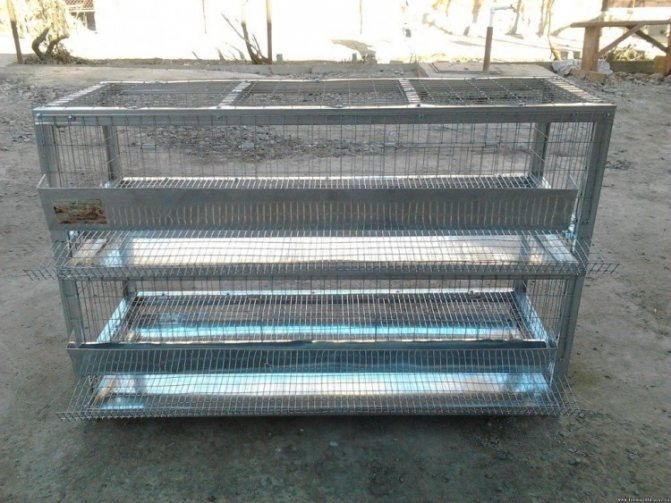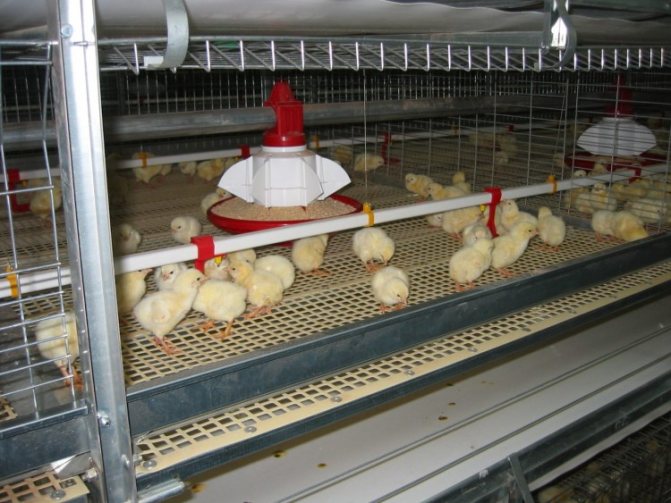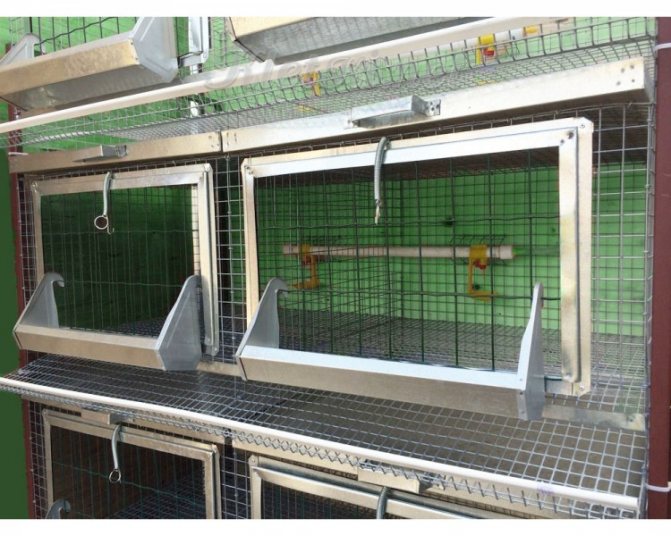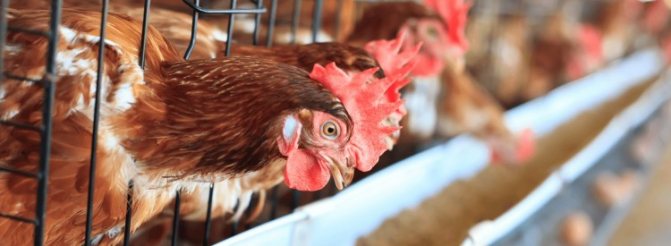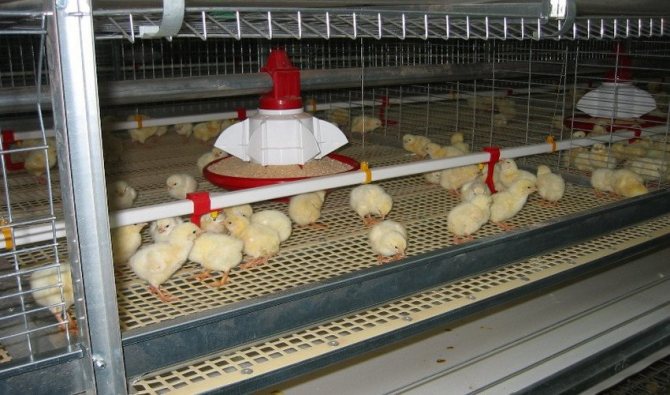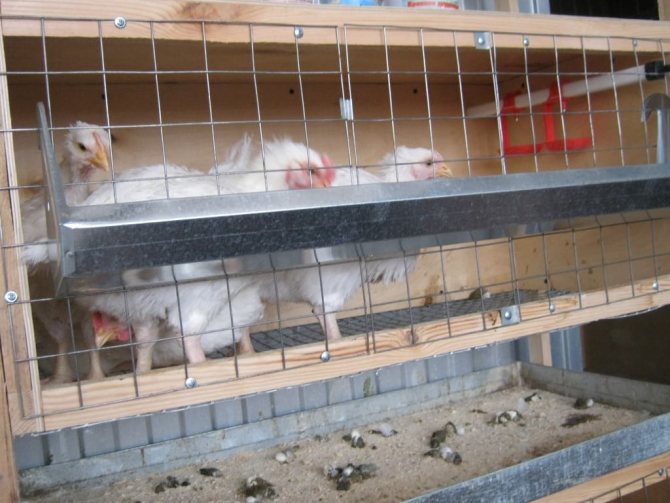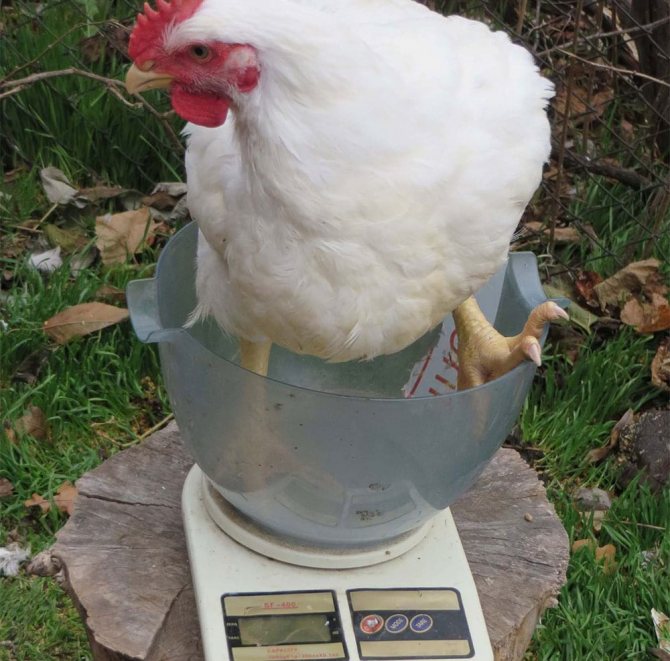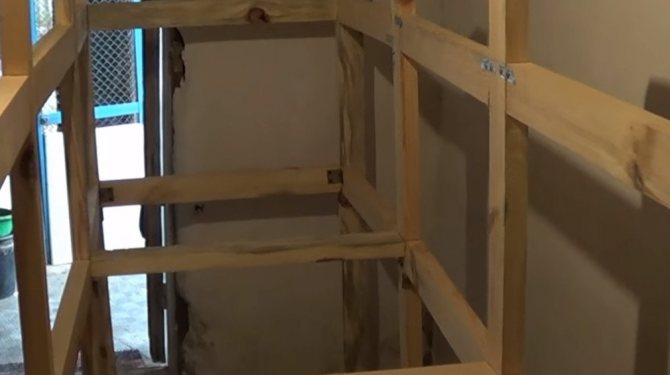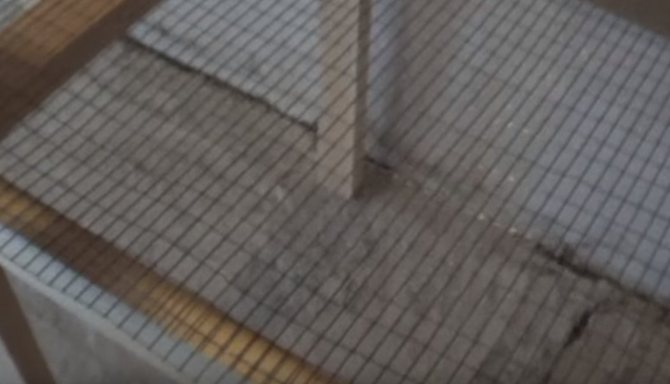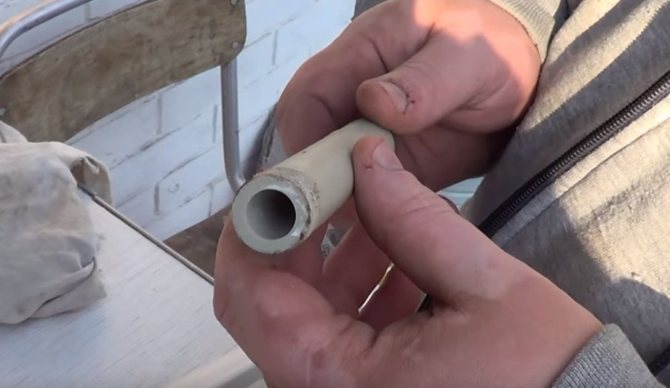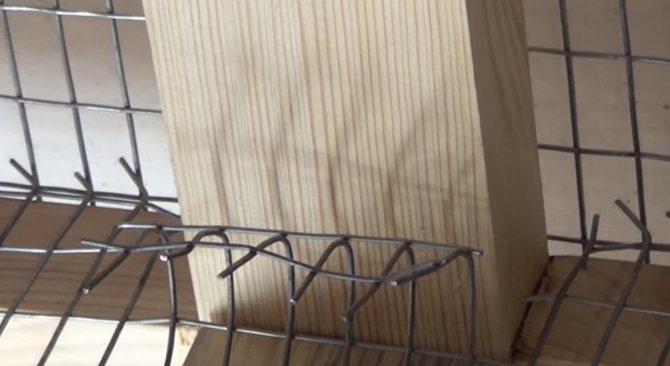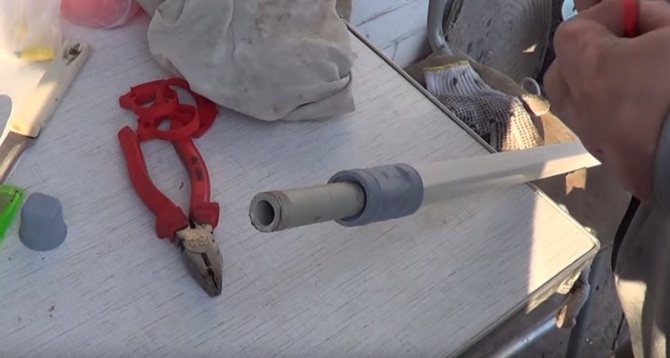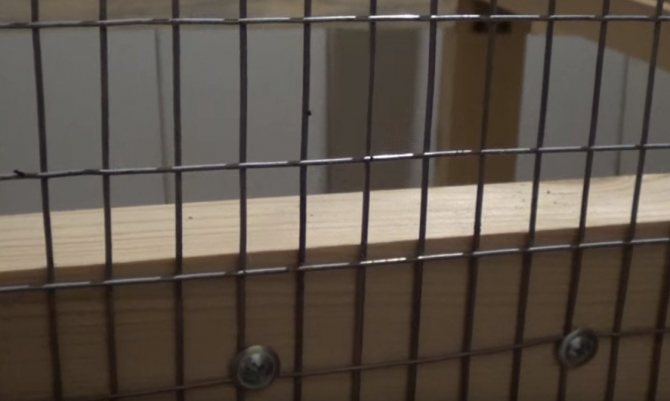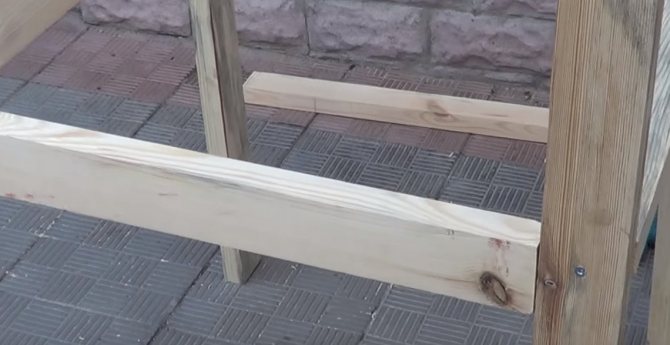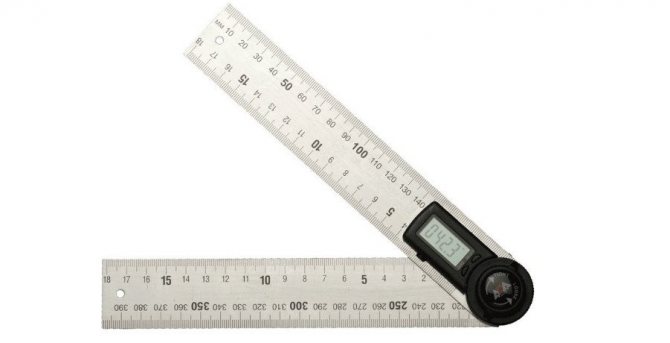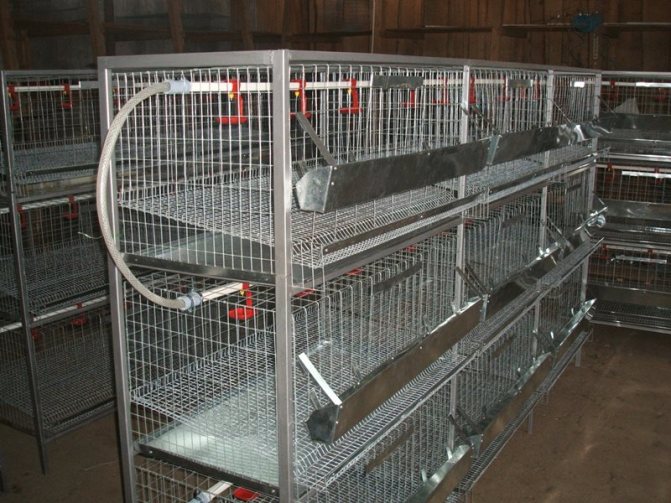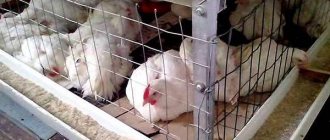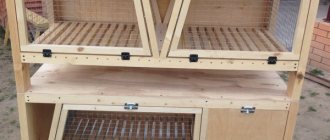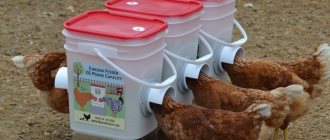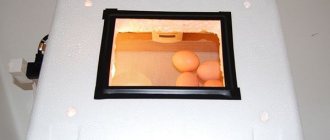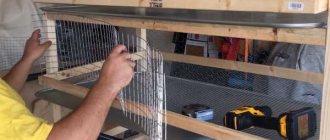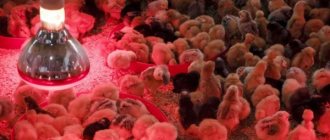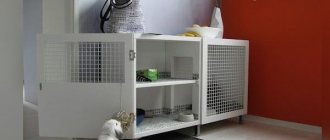»Poultry» Chickens »Making cages for broilers with their own hands
0
468
Article rating
For the successful breeding of broiler chickens, it is important to organize the proper housing conditions. Meat breeds gain mass faster if they are limited in mobility. Therefore, farmers often make broiler cages with their own hands or buy ready-made, new designs.
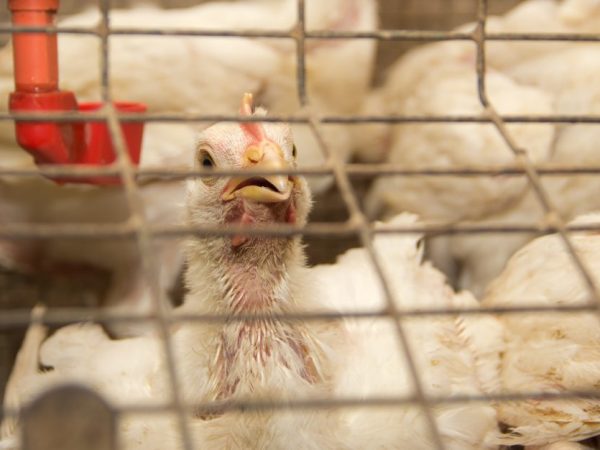
Making cages for broilers
Design features
The cage will need a separate room where it will be concentrated. The process of making a cage must be taken very seriously. If you do not create full-fledged conditions, then the chicks will grow and develop poorly.
If home-made constructions are used to keep broilers, then such content has the following advantages:
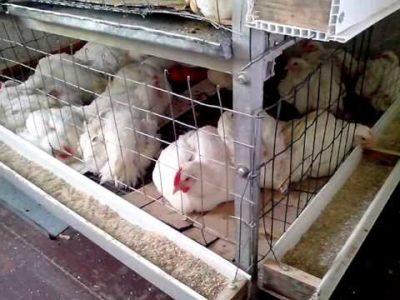

compactness in keeping chicks, since the dimensions of the structure for broilers require a minimum of space;- ease of maintenance of the structure. Broiler cages are easy to maintain. It is very easy to remove garbage and droppings, since the cage is equipped with a pallet;
- ease of construction. It is possible to make a cage for broilers with your own hands, even from window frames;
- safe keeping of the rest of the pets that are in the barn. When installing structures for chickens, it is possible to exclude the possibility of contact of birds with other inhabitants of the room;
- the process of feeding the chicks is simplified. The main thing here is to properly organize feeding in the cage, since food containers are placed outside.
Important! The home for the chicks should be convenient in terms of maintenance. To save space, you can make a cage battery for broilers. Their installation is carried out in several tiers. To breed 150,000 individuals, it is necessary to use batteries with dimensions of 25x120 m.
Each structure is equipped with manure lifts, feed and water supply systems. If you keep chicks in a private backyard, then the cell batteries are removed by hand. So it is important to consider how to simplify the process of removing droppings, feeding broilers and drinking them.
There are certain features of broiler cages:
- When choosing a material for the bottom of the structure, you must choose one that is at least 2.5 cm thick. Moisture-resistant plywood is best suited. It is characterized by increased strength, does not deform under the influence of moisture and has a long service life.
- If the walls of the cage are made of rods, then a distance must be maintained between two adjacent rods, which will not prevent the chicks from gaining access to food.
- The device of feeders requires special attention. To make them, you must use thin tin. It is flexible, does not rust and is light in weight. You just need to think about so that the feed does not spill out of the trough.
- Fresh and clean water is very important for birds. Self-made drinkers are not suitable, so you can purchase a ready-made version. It is best to use an automatic nipple drinker.
How do they differ from ordinary ones?
There is not much difference between the cages built for broilers and small chicks. The only thing to consider is the size of the structure.For small chicks, you need to equip a cage, given that no more than 25 individuals can fit on 1 m2, but 10-15 adults.
Features, pros and cons of broiler cages
Keeping birds in this way is more profitable compared to outdoor breeding. This is due to the shorter growth duration. Chickens do not need much feed.
The main advantages of the technique include the following:
- Saving space. This helps reduce electricity bills as the chicks need additional lighting, heating and ventilation.
- Reduced feed consumption. This is due to the fact that birds do not scatter or trample on food. Reducing physical activity helps you build mass faster. This is due to the fact that energy is spent on growth, and not on physical activity.
- Minimum contact with other birds. With this method, only birds placed in adjacent cages can contact. Thanks to this, it is possible to timely extinguish the foci of infection.
- Ease of cleaning. This helps to reduce the likelihood of the spread of infectious pathologies. Chickens do not eat their droppings or smell ammonia.
- Optimization of bird care. This category includes not only the feeding of the birds, but also the constant veterinary examination.
For large-scale production, this method is considered preferable. The key benefit is the rapid increase in body weight. This allows you to reduce fattening by 1 week and significantly increase profits..
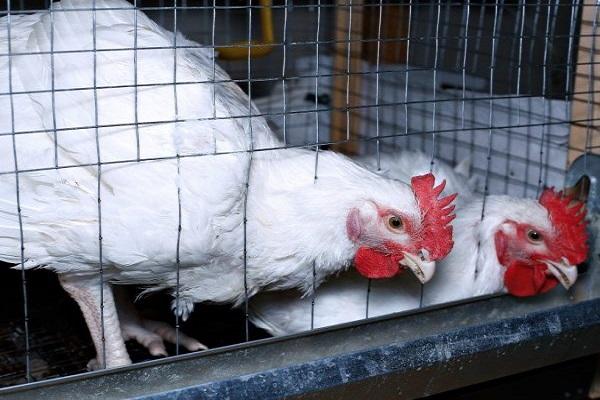

The disadvantages of the technique include the following:
- significant costs for cages and necessary fixtures;
- the need to maintain a special climate in a room with chickens - it is important to ensure the correct temperature parameters, full ventilation and lighting;
- the need to purchase specialized feed for proper nutrition of chickens;
- the risk of problems with the paws with an impressive body weight;
- the need for constant cleaning of trays;
- deterioration in taste.
When the cages are freed from chickens, disinfection is invariably performed. This helps to avoid the risk of infection for the next batch of birds.
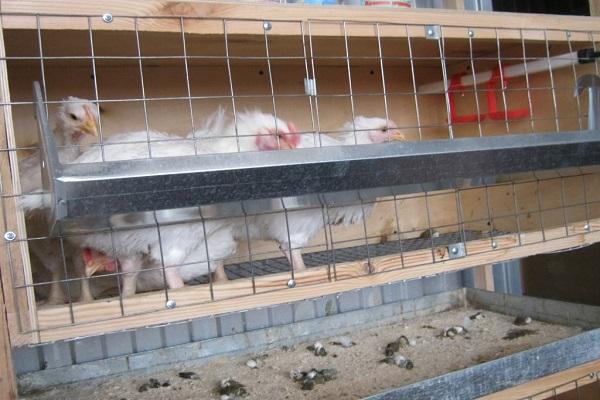

Photos and drawings of successful DIY options
Look at photos and drawings of cells that can be built at home from different materials, including timber.
Zootechnical norms
Breeding broilers at home in cages is carried out in strict accordance with established standards. Only their observance will allow you to grow birds healthy and weighty.
In general, broiler growing technology includes the following nuances:
- Daily chicks are placed only in a warm room. It is desirable that on the first day after hatching, the temperature in the room is within 32 to 34 degrees. In the future, this indicator begins to decrease (0.2 degrees per day), and by the end of the first week the temperature in the barn should not exceed 16-18 degrees.
- Air humidity also plays an important role, since the health of chickens and the rate of weight gain directly depend on it. It is important that the humidity in the room for chickens and adults does not exceed 50-70%.
- Attention should be paid to feeders, more precisely, to their number. If you are using grooved models, one container will be sufficient for two individuals. When using large round feeders, one specimen will be sufficient for 40-70 heads.
- Young chickens are watered from vacuum drinkers (1 drinker per 50 birds), and for adult chickens it is better to install nipple models. One such drinker will be enough to provide water for 10-20 heads.
There are enough ready-made drawings of cages for broilers with different heights, widths and capacities on the Web.Knowing the size of the room in which the birds will live, and the approximate number of individuals, you can easily make such cages yourself. More detailed installation instructions can be found in the sections below.
Types of structures
Today there are several types of chicken cages. Among the unusual structures are cages built from a wooden barrel. Only the structure must be clean and disinfected. Cell batteries remain equally successful. They differ in size, capacity for:
- 10 individuals;
- 20 heads;
- 30 chickens.
Reference! For broilers, aviary cages will be a good option. There the birds are on the mesh floor. Cells can be single or multi-storey.
Necessary materials
To build a broiler cage, the following materials must be used:
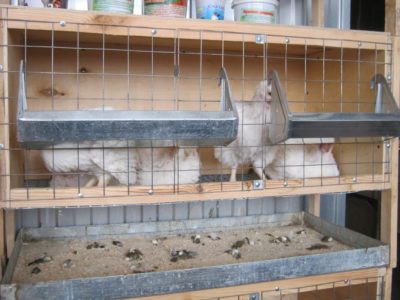

Durable plywood sheets. They are necessary in order to complete the floor and walls for the cage. Using plywood makes an excellent cage battery for broilers of various ages. This kind of design is perfectly suitable for growing meat breed chicks.- Metal parts. Of these, it will be boring to receive the main supporting structures of the cell. Since a bird house, with its small dimensions, must withstand significant weight, it is worth making them quite strong.
- Wooden slats. They are required for corners and horizontal strips.
- High strength metal mesh. Its selection should be made taking into account the need to withstand the weight of the birds. Using the mesh, you can make the walls of the structure, the roof.
For fasteners, you must use self-tapping screws or screws.
Difference between broiler designs and conventional cages
There are no differences between a do-it-yourself broiler cage and a chicken rearing cage as such. The exception is the dimensions of the structure.


If you are building a cage for chicks, then it must be built at the rate of 1m² for 25 chicks. The size must be larger for keeping adults.
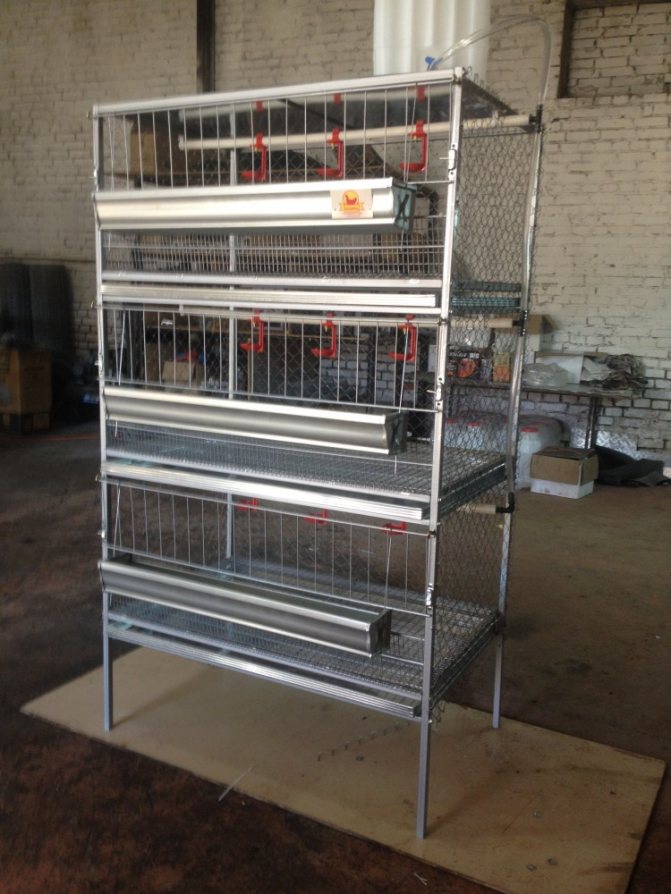

Dimensions (edit)
For birds, space matters. If it is necessary to breed 10 heads of broilers, then 1 m2 must be allocated for them. Accordingly, for 20 individuals, 2 m2 will be required. But the chicks will grow and gain weight quickly, so you can avoid overcrowding if you place 10 adult broilers on 1.5 m2.
Such designs will create optimal conditions for the birds. Using a similar formula, you can calculate the cage size for a large number of chickens.
Recommendation! For more efficient operation of the structure, it is best to perform it in two tiers. This will increase the usable area and will be an excellent option for raising chickens in outbuildings.
Growing stages
Broilers are meat hybrids. They are characterized by rapid growth and rapid weight gain. When raising birds, it is necessary to quickly achieve maximum weight gain.
Broilers are raised for a maximum of 50-70 days. Subsequently, the growth decreases, and the feed costs increase. Chicks should be purchased when they are 10 days old. The highest mortality rate is observed up to this point. It costs 50-70 days to feed the birds. During this period, they reach 2.3-2.5 kilograms. After that, the chickens are slaughtered.
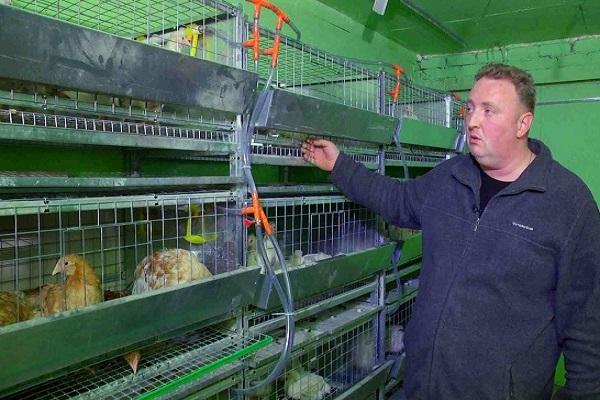

It should be borne in mind that part of the livestock is selected for earlier slaughter in 35 days. For this purpose, the largest individuals are used. This frees up space and eliminates food competition..
Growing broilers in cages is a laborious process that has many advantages. To get a good result, it is recommended to organize the proper bird care.
Manufacturing process
To make a broiler cage, you must use the following instructions:
- Making a drawing. The required dimensions must be displayed on it.It is thanks to the drawing that the required volumes of building materials can be determined before the start of construction.
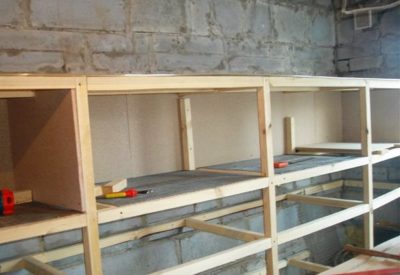

Make 6 racks with a size of 7x2 cm. The length of each rack is 165 cm. Using 11 racks, form the crate. For this, 6 slats with a section of 3x2 cm are used, 3 slats - 10x2 cm and 2 slats - 5x2 cm.For each slat, the length should be 140 cm.- Now you can proceed to making the side walls. For this, ordinary plywood sheets are suitable, the dimensions of which are 57.5x30.5 cm.
- For the manufacture of pallets, metal sheets must be used. The pallets are 20 cm high, 67 cm wide and 30.5 cm long.
- The feeder and drinker can be purchased separately or made with your own hands using the metal plates that were used to make the pallets. The feeders are fixed with brackets.
- The open part of the structure is made of a mesh with wide cells. This will allow the chicken to stick its head out freely to eat.
- If you plan to move the battery of cells, then install small wheels on the bottom.
- A plywood sheet can be used as a roof for the structure. It will be 70 cm long and 140 cm wide.
- Proper lighting is essential for broiler cages. It is best to use LED lighting. For example, a 2 meter long LED lamp would be an excellent option. It can illuminate a 3 meter cage. In this case, the light will be distributed evenly over the entire width of the structure.
Basic rules for growing broilers at home
Breeding broilers at home differs from industrial ones in the amount of caring for their pets - you can use different methods of feeding, keeping, caring for different breeds or ages.
Accommodation
There is an opinion that it is quite easy to raise birds in cages. This is not at all the case - this method of housing involves the fulfillment of many conditions for the chicken to feel comfortable and steadily gain weight.
In cold weather, the cells are placed in an insulated barn with sufficient lighting. It is also possible to use the basement, where all the necessary communications are carried out.
In summer, poultry houses can be set up under a stationary awning or agrotextile awning - rapidly growing broilers are not afraid of fresh night air and daytime heat. From environmental influences (insects, animals), the location of the cages can be protected with a net and treated with insecticides around the perimeter.
Important! Often “food competition” arises in the cells, when stronger individuals do not allow others to approach the feeder, simply covering it with their dimensions. Such birds are removed from the cage and slaughtered first.
Feeding
Food for birds should be readily available. Feeders need to be equipped so that each individual can be satiated when she wanted it, and not when she managed to push her way to the feed.
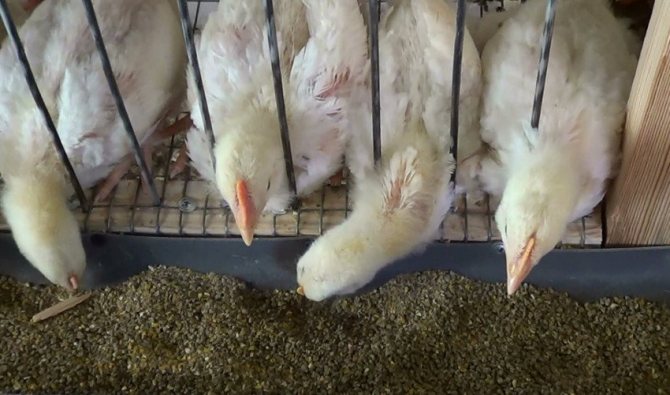

The diet of babies includes boiled eggs, chopped greens, millet. As they grow older, chickens receive wheat, shell rock, bone meal and vitamin preparations in addition to food. When a broiler approaches marketable conditions, it is fed with roughage that helps to gain weight - sunflower, corn, wheat, mixed feed.
In dry feed mixtures, you can add greens of both garden crops and field herbs, and a mash of vegetables - pumpkin, beets, cabbage, carrots. Broilers will be happy to eat not only the flesh, but also the skins of the vegetables.
Learn more about how to feed broilers properly at home and how to make your own broiler feed.
Frequent mistakes
At the design stage, it is important not to make gross mistakes, because of which you will have to redo the entire structure of the building. These include:
- Lack of protection against rodents. When drawing up a project, it is necessary that the cage be raised from the ground. Contact of the insulation with the ground is unacceptable.This can lead to the threat of rats. They are able to gnaw through wood and get inside the structure. It is better to cover the lower area between the heat insulator and the ground with broken glass.
- Use of unsuitable materials. Do not use for finishing isoplates, drywall, PVC plastic and chipboard. They accumulate moisture and break down as a result. In addition, toxic substances that are dangerous for chicks can be released. Due to high humidity, mold is formed, which leads to the development of various diseases in chickens.
It is quite possible to make a cage for chickens or chickens with your own hands. To do this, you need to choose the right materials, choose the type of structure and draw up its drawing. All the work is simple, so even a person who does not have the proper experience can cope with them.

